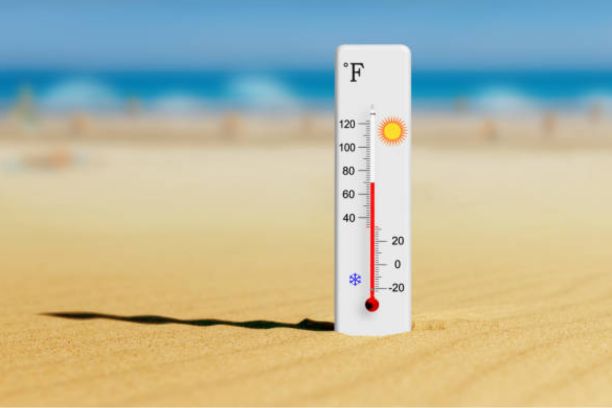Is 75 degrees hot? Often, we find ourselves in conversations about the weather, wondering if 75 degrees Fahrenheit qualifies as hot.
Here, we’ll delve into the nuances of temperature perception. We’ll explain, in a straightforward manner, how a seemingly simple number on the thermometer can have varied interpretations.
Is 75 degrees really hot? Prepare to gain insights that will help you make sense of those balmy days.
Table of contents
- Is 75 Degrees Hot?
- Is 75 Degrees Hot or Not? Here’s How to Know
- Can 75 Degrees Be Considered a Hot Temperature?
- Is 75 Degrees a Perfect Room Temperature?
- Why Does 75 Degrees Feel Different In Winter Than It Does In Summer?
- Can Humans Survive at 75 Degrees?
- How Should I Dress For 75 Degrees?
- Is 75 Degrees Hot Enough to Go Swimming?
- Is 75 Degrees Too Hot For a Dog?
- Is 75 Degrees Too Hot For a PC?
- 5 Locations That Enjoy 75-Degree Weather
- FAQs
- Conclusion
- References
- Recommendations
Is 75 Degrees Hot?
75 degrees is a measure of temperature. Think of it as a nice, warm day, but not too hot. Imagine wearing short sleeves and enjoying the outdoors comfortably. It’s the kind of weather that’s perfect for a picnic or a walk in the park. In short, 75 degrees usually means pleasant and warm weather.
Whether 75 degrees Fahrenheit is considered hot depends on individual preferences and geographical context. In temperate regions, 75°F often falls within the comfortable and pleasant range, making it a popular choice for outdoor activities.
However, it may feel hot to those accustomed to cooler climates. In contrast, places with scorching summers might regard 75°F as relatively cool. The perception of heat is influenced by factors such as humidity, personal tolerance, and acclimatization.
So, while 75 degrees can be delightful for some, others might find it warm or even hot, illustrating that our perception of temperature is subjective and context-dependent.
Is 75 Degrees Hot or Not? Here’s How to Know
The question of whether 75 degrees Fahrenheit is hot or not depends on several factors. While many individuals perceive 75 degrees as a comfortably warm temperature, it is important to recognize that this perception is subjective.
Well, deciphering whether 75 degrees Fahrenheit qualifies as a hot temperature is a nuanced affair, contingent on several variables:
- Ground Surface: Your location plays a role. On asphalt or concrete, 75 degrees can feel scorching due to these surfaces’ heat-absorbing properties. In contrast, grassy or watery areas absorb sunlight and maintain a more pleasant 75-degree atmosphere.
- Activity Level: Engaging in physical activities like exercise can elevate your body temperature. When you’re active on a 75-degree day, it might feel hotter because your body struggles to cool down in already warm air.
- Cloud Cover: The presence or absence of clouds matters. On cloudy days, 75 degrees often feels warm as you’re shielded from direct sunlight. Conversely, under a blazing sun with no clouds, 75 degrees can feel hot because you’re exposed to relentless solar radiation.
- Wind: Wind can modify temperature perception. A breeze may make 75 degrees feel cooler by dissipating heat from your skin. Without wind, you’re subjected to stifling conditions, especially in direct sunlight.
Can 75 Degrees Be Considered a Hot Temperature?
While 75 degrees Fahrenheit is generally considered a comfortably warm temperature, it can be perceived as hot under specific circumstances. The perception of heat at this temperature is influenced by several factors.
- Personal Tolerance: Individuals have varying levels of tolerance to heat. What one person finds pleasantly warm, another may consider hot.
- Environmental Conditions: Direct exposure to sunlight on a clear day can make 75 degrees feel hotter due to the sun’s radiant heat.
- Humidity: High humidity levels can make 75 degrees feel significantly hotter, as it impairs the body’s natural cooling mechanism through sweat evaporation.
- Activity Level: Engaging in physical activities can raise body temperature, making 75 degrees feel hot when combined with exertion.
Is 75 Degrees a Perfect Room Temperature?
The idea of 75 degrees Fahrenheit as a “perfect room temperature” can be influenced by your location and local conditions. In North America or Europe, 75 degrees is often seen as a comfortable indoor setting.
However, in some African countries like Sudan or Niger, where outdoor conditions at this temperature can be harsh, indoor settings might be kept cooler if possible, to provide relief from the heat and dryness outside.
In humid climates like parts of Asia, a room temperature of 75 degrees might feel stuffier, leading people to prefer a cooler indoor environment. Overall, while 75 degrees is a good starting point, your comfort level will depend on what you’re accustomed to and the specific conditions in your part of the world.
Why Does 75 Degrees Feel Different In Winter Than It Does In Summer?
The sensation of 75 degrees varies between winter and summer due to external temperature disparities and the body’s physiological response.
When you set your thermostat to 75 degrees Fahrenheit in winter, it often feels warm and inviting because the outside environment is typically colder. Homes act as heat reservoirs, retaining warmth generated by heating systems, resulting in a comfortable indoor climate.
However, in summer, that same 75-degree setting might feel uncomfortably warm. This disparity arises from the higher outdoor temperatures, which cause houses to absorb and trap heat.
While air conditioning systems work diligently to expel hot air and cool the indoors, the contrast between indoor and outdoor temperatures can still lead to a perception of warmth inside.
The human body’s perception of 75 degrees is significantly influenced by the surrounding climate, making the same indoor temperature setting feel distinctively different in winter and summer.
Can Humans Survive at 75 Degrees?
Absolutely, humans can not only survive but also thrive at 75 degrees Fahrenheit (approximately 24 degrees Celsius). This temperature is generally comfortable for most people. However, it’s worth noting that what’s comfortable can vary depending on where you are in the world.
For example, in some countries in Africa like Sudan or Niger, a temperature of 75 degrees Fahrenheit might be considered a little harsh, especially when combined with other environmental factors like dry air and intense sunlight.
People in these regions often manage by staying hydrated, wearing lightweight and breathable clothing, and seeking shade during the hottest parts of the day.
However, in other continents like North America or Europe, 75 degrees Fahrenheit is often considered ideal for outdoor activities and is generally not seen as harsh. So, the comfort level of this temperature can depend on various factors, including geographic location and what one is accustomed to.
How Should I Dress For 75 Degrees?
For 75 degrees, if you’re in North America or Europe, light and comfy clothing works well. T-shirts, shorts, or light pants are good. A summer dress could also be nice. A light jacket might come in handy if you’re out all day.
Now, if you’re in certain parts of Africa where 75 degrees feels harsher due to factors like dry air and strong sun, you might want to opt for lightweight but long-sleeve shirts and long pants to protect your skin. Breathable fabrics like cotton are ideal. A wide-brimmed hat and sunglasses are also recommended to shield you from the sun.
For other continents, the key is comfort and adapting to local conditions. Whether you’re in Asia, Australia, or South America, adjust based on humidity, wind, and sun exposure. So, no matter where you are, you can be comfortable at 75 degrees!
Is 75 Degrees Hot Enough to Go Swimming?
Engaging in swimming activities in water that is 75 degrees Fahrenheit can be comfortable for some individuals.
The World Health Organization recommends water temperatures between 78 and 86 degrees Fahrenheit for safe and comfortable swimming.
However, it’s essential to exercise caution when dealing with extreme water temperatures, as they can have health implications.
Very hot water, such as that in a hot tub above 104 degrees Fahrenheit, can lead to a rapid drop in blood pressure, potentially causing fainting or dizziness. Conversely, swimming in water colder than 70 degrees Fahrenheit may result in an elevated heart rate and blood pressure.
For open-water competitions, wetsuits are often mandated when water temperatures drop below 64 degrees Fahrenheit due to increased health risks.
Is 75 Degrees Too Hot For a Dog?
A temperature of 75 degrees Fahrenheit is generally safe for dogs, but certain factors should be considered. Dogs can tolerate this temperature, but it may become uncomfortable in direct sunlight without shade or proper hydration. Short-nosed breeds are more susceptible to heat-related issues.
It’s crucial to ensure access to water, provide shaded areas, and avoid excessive exercise during hot weather.
Always be mindful of your dog’s well-being and signs of overheating, such as excessive panting, drooling, or lethargy. When in doubt, consult with a veterinarian for specific guidance on your dog’s heat tolerance.
Is 75 Degrees Too Hot For a PC?
A temperature of 75 degrees Fahrenheit is generally not too hot for a personal computer (PC). In fact, it falls within the comfortable and safe range for most computer components. PCs are designed to operate within a wide temperature range, typically between 50 and 95 degrees Fahrenheit.
However, it’s crucial to ensure proper ventilation and cooling for your PC, especially if it generates a significant amount of heat during heavy usage or gaming. Adequate airflow, case fans, and a well-maintained cooling system help prevent overheating and ensure optimal performance.
If your PC consistently operates in an environment above 95 degrees Fahrenheit, it may lead to thermal issues, potentially affecting the longevity and performance of internal components.
5 Locations That Enjoy 75-Degree Weather
Some locations around the world are renowned for their pleasant 75-degree weather and temperate climates, making them popular choices for residents and travelers seeking a comfortable environment. Here are five such locations:
Maui, Hawaii:
Maui, part of the Hawaiian archipelago, offers a unique blend of tropical and temperate climates. With approximately 276 days of sunshine annually, Maui experiences warm but not scorching temperatures. Summer temperatures typically peak around 82 degrees Fahrenheit, while winter temperatures remain above 60 degrees.
Maui’s mountainous terrain contributes to its milder climate, with mountain elevations cooling the island by about 20 degrees compared to other Hawaiian regions. The constant ocean breeze, though making the area humid, ensures a relatively comfortable atmosphere.
Algarve, Portugal:
Portugal’s Algarve region boasts a Mediterranean climate despite its Atlantic Ocean proximity. Winters feature mild temperatures, around 61 degrees Fahrenheit in January, while summers remain pleasant, with August highs around 84 degrees.
Coastal areas benefit from refreshing ocean breezes, and the Mediterranean Sea’s influence warms the surrounding waters. Algarve enjoys abundant sunshine, with approximately 300 sunny days annually, making it an appealing destination for those seeking year-round temperatures around 75 degrees.
Medellín, Colombia:
Medellín, situated at an elevation of 4,900 feet above sea level and just north of the equator, maintains an exceptionally consistent temperature throughout the year. Temperature variations are minimal, with September reaching around 80 degrees Fahrenheit and July, the hottest month, seeing temperatures of about 82 degrees.
This stability is attributed to Medellín’s subtropical highland climate. While rainfall is more likely from March to November, the climate remains temperate, making it an ideal choice for those who prefer consistent temperatures.
Perth, Australia:
Perth, the capital of Western Australia, offers temperate weather for most of the year. The city’s daily average temperature hovers around 76.6 degrees Fahrenheit, providing comfort and warmth. Summers can reach a high of 88 degrees, occurring in January due to the southern hemisphere’s seasonal differences.
Winter nights may dip to around 47 degrees, still relatively mild compared to colder climates. Perth’s proximity to the Southern Indian Ocean ensures a cooling ocean breeze, and the city boasts some of the cleanest air quality worldwide.
While Perth itself enjoys temperate conditions, Australia’s outback regions offer a stark contrast, with scorching temperatures reaching up to 120 degrees Fahrenheit.
San Diego, California, USA:
San Diego, located on the southern coast of California, is renowned for its near-perfect weather year-round. With an average daily temperature of around 70-75 degrees Fahrenheit, it offers a mild and comfortable climate.
Summers in San Diego are warm, with temperatures typically reaching the mid-70s to low 80s. Winters are mild and rarely drop below 50 degrees. The city benefits from the Pacific Ocean’s influence, which moderates temperature extremes.
San Diego enjoys plenty of sunshine, making outdoor activities and beach visits popular throughout the year. The city’s climate is one of the main reasons it’s often referred to as “America’s Finest City,” attracting residents and visitors alike with its consistent and pleasant temperatures.
FAQs
Yes, 75-degree weather is generally considered warm and pleasant for outdoor activities and comfortable living.
Yes, 75 degrees is typically warm enough for shorts, making them a comfortable and suitable choice for this temperature.
In 75-degree weather, opt for lightweight clothing like T-shirts, shorts, sundresses, and sandals. Don’t forget sunglasses, sunscreen, and a hat for sun protection.
70 degrees is typically considered a comfortable and mild temperature. It’s neither hot nor cold, falling into the range of pleasantly warm for many people.
Conclusion
Whether 70 degrees is hot or cold varies among individuals. Generally, it falls into the category of mild and comfortable temperatures. In colder regions, it might be considered warm, while in hot climates, it could be seen as relatively cool. Personal comfort and activities play a significant role in determining whether 70 degrees is hot or cold for any given person.
References
- thecoldwire.com – Is 75 Degrees Hot?
- easus.com – IS 75 Degrees Too Hot For a PC?
- reddit.com – Does 75 degrees Fahrenheit and cloudy feel warm or hot?
- answers.com – Is 75 degrees Fahrenheit cold or hot?






